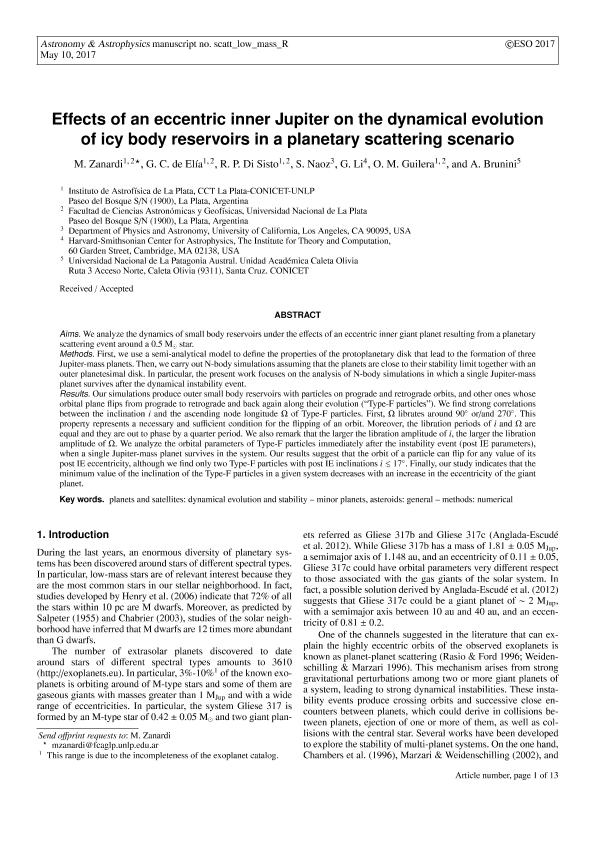Mostrar el registro sencillo del ítem
dc.contributor.author
Zanardi, Macarena

dc.contributor.author
de Elia, Gonzalo Carlos

dc.contributor.author
Di Sisto, Romina Paula

dc.contributor.author
Naoz, S.
dc.contributor.author
Li, G.
dc.contributor.author
Guilera, O. M.
dc.contributor.author
Brunini, A.
dc.date.available
2018-04-06T13:03:58Z
dc.date.issued
2017-07
dc.identifier.citation
Zanardi, Macarena; de Elia, Gonzalo Carlos; Di Sisto, Romina Paula; Naoz, S.; Li, G.; et al.; Effects of an eccentric inner Jupiter on the dynamical evolution of icy body reservoirs in a planetary scattering scenario; EDP Sciences; Astronomy and Astrophysics; 605; 7-2017; A64
dc.identifier.issn
0004-6361
dc.identifier.uri
http://hdl.handle.net/11336/41046
dc.description.abstract
Aims. We analyze the dynamics of small body reservoirs under the effects of an eccentric inner giant planet resulting from a planetary scattering event around a 0.5 M⊙ star. Methods. First, we used a semi-analytical model to define the properties of the protoplanetary disk that lead to the formation of three Jupiter-mass planets. Then, we carried out N-body simulations assuming that the planets are close to their stability limit together with an outer planetesimal disk. In particular, the present work focused on the analysis of N-body simulations in which a single Jupiter-mass planet survives after the dynamical instability event. Results. Our simulations produce outer small body reservoirs with particles on prograde and retrograde orbits, and other ones whose orbital plane flips from prograde to retrograde and back again along their evolution (“Type-F particles”). We find strong correlations between the inclination i and the ascending node longitude Ω of Type-F particles. First, Ω librates around 90° or/and 270°. This property represents a necessary and sufficient condition for the flipping of an orbit. Moreover, the libration periods of i and Ω are equal and they are out to phase by a quarter period. We also remark that the larger the libration amplitude of i, the larger the libration amplitude of Ω. We analyze the orbital parameters of Type-F particles immediately after the instability event (post IE orbital parameters), when a single Jupiter-mass planet survives in the system. Our results suggest that the orbit of a particle can flip for any value of its post IE eccentricity, although we find only two Type-F particles with post IE inclinations i ≲ 17°. Finally, our study indicates that the minimum value of the inclination of the Type-F particles in a given system decreases with an increase in the eccentricity of the giant planet.
dc.format
application/pdf
dc.language.iso
eng
dc.publisher
EDP Sciences

dc.rights
info:eu-repo/semantics/openAccess
dc.rights.uri
https://creativecommons.org/licenses/by-nc-sa/2.5/ar/
dc.subject
Planets
dc.subject
Minor Planets
dc.subject
Methods: Numerical
dc.subject
Asteroids
dc.subject
Satellites
dc.subject
Dynamical Evolution
dc.subject
Stability
dc.subject.classification
Astronomía

dc.subject.classification
Ciencias Físicas

dc.subject.classification
CIENCIAS NATURALES Y EXACTAS

dc.title
Effects of an eccentric inner Jupiter on the dynamical evolution of icy body reservoirs in a planetary scattering scenario
dc.type
info:eu-repo/semantics/article
dc.type
info:ar-repo/semantics/artículo
dc.type
info:eu-repo/semantics/publishedVersion
dc.date.updated
2018-03-26T14:39:00Z
dc.journal.volume
605
dc.journal.pagination
A64
dc.journal.pais
Francia

dc.journal.ciudad
Paris
dc.description.fil
Fil: Zanardi, Macarena. Universidad Nacional de La Plata. Facultad de Ciencias Astronómicas y Geofísicas; Argentina. Consejo Nacional de Investigaciones Científicas y Técnicas. Centro Científico Tecnológico Conicet - La Plata. Instituto de Astrofísica La Plata. Universidad Nacional de La Plata. Facultad de Ciencias Astronómicas y Geofísicas. Instituto de Astrofísica La Plata; Argentina
dc.description.fil
Fil: de Elia, Gonzalo Carlos. Universidad Nacional de La Plata. Facultad de Ciencias Astronómicas y Geofísicas; Argentina. Consejo Nacional de Investigaciones Científicas y Técnicas. Centro Científico Tecnológico Conicet - La Plata. Instituto de Astrofísica La Plata. Universidad Nacional de La Plata. Facultad de Ciencias Astronómicas y Geofísicas. Instituto de Astrofísica La Plata; Argentina
dc.description.fil
Fil: Di Sisto, Romina Paula. Consejo Nacional de Investigaciones Científicas y Técnicas. Centro Científico Tecnológico Conicet - La Plata. Instituto de Astrofísica La Plata. Universidad Nacional de La Plata. Facultad de Ciencias Astronómicas y Geofísicas. Instituto de Astrofísica La Plata; Argentina. Universidad Nacional de La Plata. Facultad de Ciencias Astronómicas y Geofísicas; Argentina
dc.description.fil
Fil: Naoz, S.. University of California at Los Angeles; Estados Unidos
dc.description.fil
Fil: Li, G.. Harvard-Smithsonian Center for Astrophysics; Estados Unidos
dc.description.fil
Fil: Guilera, O. M.. Consejo Nacional de Investigaciones Científicas y Técnicas. Centro Científico Tecnológico Conicet - La Plata. Instituto de Astrofísica La Plata. Universidad Nacional de La Plata. Facultad de Ciencias Astronómicas y Geofísicas. Instituto de Astrofísica La Plata; Argentina. Universidad Nacional de La Plata. Facultad de Ciencias Astronómicas y Geofísicas; Argentina
dc.description.fil
Fil: Brunini, A.. Universidad Nacional de la Patagonia Austral; Argentina
dc.journal.title
Astronomy and Astrophysics

dc.relation.alternativeid
info:eu-repo/semantics/altIdentifier/url/https://www.aanda.org/articles/aa/abs/2017/09/aa30411-17/aa30411-17.html
dc.relation.alternativeid
info:eu-repo/semantics/altIdentifier/doi/http://dx.doi.org/10.1051/0004-6361/201730411
Archivos asociados
